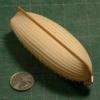-
Posts
13,290 -
Joined
-
Last visited
Content Type
Profiles
Forums
Gallery
Events
Everything posted by druxey
-
Um, no iron bands on shipboard trucks: they would wear the deck out prematurely. Only land-based fort trucks were banded, because the stone would abrade the wood.
- 310 replies
-
- cheerful
- Syren Ship Model Company
-
(and 1 more)
Tagged with:
-
Eventually even well seasoned wood will show plank seams through paint. Humidity variation is the cause. Think of it as a badge of ageing.
- 19 replies
-
- separation
- wood movement
-
(and 1 more)
Tagged with:
-
Superb, as usual!
-
You guys are too much! Actually, that is very funny. Greg - please don't post again until you are off the tequilas.
- 889 replies
-
Something for you contemplate when suffering from insomnia, Greg? There was a discussion earlier in this thread (around #420) on humidity control and seasonal issues.
- 889 replies
-
On a 64 gun ship there were seven turns of line around the drum, with the center turn nailed to the drum. There were then 3 1/2 turns possible to either side. I once worked out the geometry of this arrangement and it allowed the tiller to turn almost exactly from one end of the sweep to the other, allowing maximum helm each way.
-

Echo by davec - FINISHED - cross-section
druxey replied to davec's topic in - Build logs for subjects built 1751 - 1800
Happy New Year to you also, Dave. Apart from practical problems making ebony treenails - I wouldn't. It would look as if your model had the pox! The contrast in tone would be much too great. As for using ebony on the wale - you're a braver man than me. Looks nice, though.- 127 replies
-
You are experiencing what is called cumulative error. If each 3/16" plank is slightly under width by even a few thousandths of an inch, the second strake will be off by double that amount, the third triples it, and so on. Bevelling may be part of your issue. And then it shows up and bites you! It's unfortunate, but it's happened to all of us and is part of our learning experience. You may be better off cutting your planks slightly over-width from sheet material and sanding them down to fit the edges accurately to your mark-out. Yes, more time-consuming, but it makes things right.
-

HMS Naiad 1797 by albert - FINISHED - 1/48
druxey replied to albert's topic in - Build logs for subjects built 1751 - 1800
Beautiful work as usual! The metalwork looks very neat indeed. -

"Gunnery notes" from William Rivers (*1755, †1817)
druxey replied to dafi's topic in Nautical/Naval History
That makes sense as the marines' red uniform coats would make very visible targets. -

"Gunnery notes" from William Rivers (*1755, †1817)
druxey replied to dafi's topic in Nautical/Naval History
until we? -
Adding the quarter deck beams makes your model look much closer to finished - assuming you are not going to spar her! Looks great, Toni.
- 1,449 replies
-
When in doubt, follow your Pegasus draught. The Mylar draught is based on Atalanta.
- 889 replies
About us
Modelshipworld - Advancing Ship Modeling through Research
SSL Secured
Your security is important for us so this Website is SSL-Secured
NRG Mailing Address
Nautical Research Guild
237 South Lincoln Street
Westmont IL, 60559-1917
Model Ship World ® and the MSW logo are Registered Trademarks, and belong to the Nautical Research Guild (United States Patent and Trademark Office: No. 6,929,264 & No. 6,929,274, registered Dec. 20, 2022)
Helpful Links
About the NRG
If you enjoy building ship models that are historically accurate as well as beautiful, then The Nautical Research Guild (NRG) is just right for you.
The Guild is a non-profit educational organization whose mission is to “Advance Ship Modeling Through Research”. We provide support to our members in their efforts to raise the quality of their model ships.
The Nautical Research Guild has published our world-renowned quarterly magazine, The Nautical Research Journal, since 1955. The pages of the Journal are full of articles by accomplished ship modelers who show you how they create those exquisite details on their models, and by maritime historians who show you the correct details to build. The Journal is available in both print and digital editions. Go to the NRG web site (www.thenrg.org) to download a complimentary digital copy of the Journal. The NRG also publishes plan sets, books and compilations of back issues of the Journal and the former Ships in Scale and Model Ship Builder magazines.


